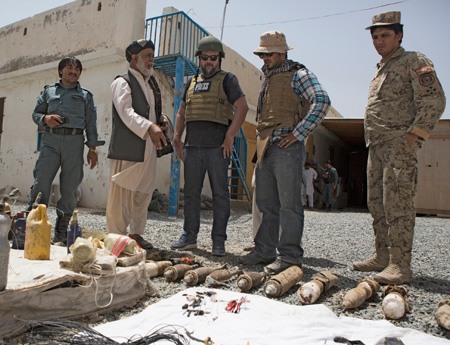What Does Vice Media Want From the Traditional TV Business?

Today’s confirmation of long-gestating plans to rebrand A+E’s H2 network for Vice Media brings the quixotic company further inside the beating heart of traditional TV. But despite the headlong embrace of Vice by the likes of 21stCentury Fox, Disney and Hearst, plus an imminent expansion of its important alliance with Time Warner’s HBO, the fit remains perhaps the most curious of any in the media business. Plenty of industry leaders still can’t quite grasp how Vice has become such a darling.
In point of fact, Vice has spent more than two decades becoming an “overnight” success. Founded in 1994 as a monthly print magazine in Montreal, the company got religion quickly about the power of digital and pivoted quickly as a way of reaching new, young audiences coveted by advertisers. Of course, fast-rising digital brands are often regarded with suspicion by traditional players and sometimes the wariness is warranted. Once-high-flying AOL swallowed up Time Warner in the poster child of megadeals gone wrong. MySpace’s acquisition by News. Corp. led to little but indigestion. The thirst for relevance and juice, especially among companies seeing erosion in traditional metrics, can easily cloud financial judgment.
So what path will the alliance with A+E, which now has a 20% stake in the company, travel? (Disney also plans an increased stake, apart from its involvement in A+E.) In some ways, it is purely a marriage of convenience. Viacom alum Tom Freston, is an advisor to Vice and, via his merchant banking firm, the Raine Group, also an investor in the company. He downplayed the significance linear TV would take in the company’s overall portfolio during a panel appearance last April at the NewFronts. “This is a digital-first brand,” he said. “It wouldn’t be the cornerstone of their business.”
Shane Smith, cofounder and CEO of Vice, agreed during a separate keynote appearance the same day as Freston’s. “Online has shown the good news about TV and the bad news about TV,” he said, “and that’s how everyone fell in love with native ads.” In the official announcement today, Smith noted the venture will bring new capital to fund a range of projects and also empower new approaches to making money from TV. As he put it, the network will be “at the pointy tip of the spear of the rapidly changing terrain of TV advertising.”
It’s hard to say what form that will take exactly, but as A+E continues to battle ratings slippage and competitive headwinds as the programming world gets ever more congested, Viceland (the network’s working title) offers a ray of hope. For Vice, since A+E troops will largely be at the operational controls, the duty of bringing the network to life will be more of a curatorial one.
Curation is a concept now on everyone’s lips but one that was woven into Vice’s fabric from early on. To hear from those who have traveled through the open-plan converted warehouse, Vice’s headquarters in the nucleus of hip, Williamsburg, Brooklyn, is a remarkable hive of activity. Branded video content, which pays the bills to enable the enterprise reporting and outsider voice that distinguishes Vice’s overall content strategy, is produced by a range of contributors. They are united by lifestyle and ethos more than corporate rank and ladder-climbing. Vice’s hierarchy and corporate culture is unlike that of almost any other TV entity and overhead is kept low. While Smith has earned a reputation for living large, reportedly racking up $300,000 restaurant tabs and buying a mansion in Santa Monica for $23 million and serving as a target for IFC spoof series, Documentary Now!, the company maintains a lean structure. The cachet of being at Vice generally trumps the perks, pay packages and C-suite structures commonly found across the river in Manhattan’s media avenues.
The resulting profit margins—though shrouded in secrecy—have captivated moguls desperate to kick-start their battered enterprises in a world of instant smart-device gratification. In 2014, Gawker published posts fueled by anonymous reports from staffers and former staffers charging that Vice kept such a tight lid on pay that it created steady turnover in the ranks. While the company posted an expletive-laced rebuttal, the most specific it got was to say that the then-400 employees are paid in a manner “competitive with comparable emerging media companies in the digital space.”
The headcount has headed northward since then, to more than 1,500 worldwide, still a fraction of that of many peers. A+E CEO Nancy Dubuc today hailed Vice for having a “unique model in the marketplace.” To bring that model to the airwaves, the companies said the production pipeline will be overseen by Spike Jonze. The film and music video auteur got his start making skateboarding videos before ascending the Hollywood A-list to direct studio features like Adaptation and Where the Wild Things Are and co-create Jackass for MTV.
Jonze promised that Viceland’s hundreds of hours of original programming will offer a unique point of view. Helpfully, from a cost standpoint, the hive in Williamsburg will offer the kind of leverage that other networks distributed on linear outlets to 70 million homes don’t have: Many of the shows announced on the slate, such as Noisey or Weediquette have direct roots in existing series already being produced online by Vice for an attractive cost and eagerly consumed by a hard-to-reach demo. All that remains is the task of scaling that for the MVPD world. If Smith’s merry band can pull that off with help from veteran A+E troops, maybe his blue-skying about a multi-billion-dollar sale or IPO, and his ultimately walking away from day-to-day operations, can become a reality.
Broadcasting & Cable Newsletter
The smarter way to stay on top of broadcasting and cable industry. Sign up below



